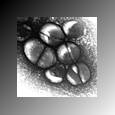 |
 |
Staphylococcal Intoxication
![]()
|
Cause and Transmission (Epidemiology): Staphylococcal intoxication is caused by the Staphylococcus aureus bacterium, which is found on most people's skin naturally. It enters food and water when infected individuals with lesions or cuts on their skin contaminate the food, then the food is allowed to incubate at room temperature before it is served. How It Affects the Body (Pathogenesis): Signs and symptoms begin to show up 2-6 hours after ingestion of contaminated food, at which point the bacteria have begun to produce a type of toxin called an enterotoxin. This toxin causes water to leave the cells in the bloodstream and enter the intestines (electrolytes, or salts like Na, Ca, K, and Cl, soon follow the water to reestablish the osmotic gradient). Once in the intestines, the water and electrolytes are quickly flushed out of the body, resulting in abdominal cramps and diarrhea; vomiting may also accompany these signs. Antibiotics are often not prescribed because the diarrhea flushes the microbes out of the body, and patients often recover within a day or two (though it is suggested to replenish lost fluids and electrolytes). |